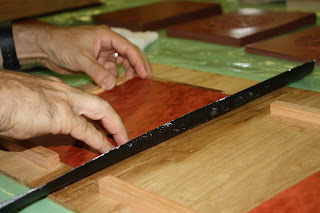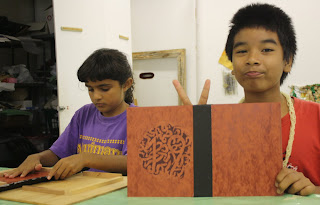
[part of the Tinfish hui]
Early in my graduate school career, if it could be called that, I took a course from Ralph Cohen. I don't remember the name of the course, or even much about it, except that we read Raymond Williams and that the very dapper Professor Cohen, who often wore a bright yellow sport coat, would occasionally wind up like the MGM lion and roar, "we know the product, but we have lost touch with the process!!!" He once alluded to napkins, how we use them without knowing who made them.
Even though I am editor of Tinfish Press, I am often distanced from the labor used to produce the issues of our journal, almost all of which have had recycled covers (tourist brochure proof sheets, x-rays, cereal boxes, bank annual report covers, and so on). Once the words go out of my hands, Gaye Chan turns them over to a graphic designer (currently Chae Ho Lee), who designs the innards. She also invites an artist to do a centerfold (this one's done by Maya Portner). And she asks someone to make covers out of recycled materials (this time Maya Portner crafted covers of the orangish brown fiber board used in expandable folders; she stamped a pattern onto them with a partially disguised 19 at the center).
As if this were not enough labor, the print shop, which staples the insides to the outsides, informed Gaye that the covers were unworkable (everyone on the design staff had thought they would work). So Gaye went back to the drawing board and devised a plan. She would cut the covers in half, make jigs to hold the pieces down, have someone cut strips of bookbinding cloth, have another someone add glue to the cloth, and then put the pieces back together with the cloth. The print shop would then staple the remade covers to the insides.


For two of the last three Sundays, Maya and several of us have gotten together to put together 500 covers. It's been a difficult process, and involved the labor of 10 or so people for approximately 4-8 hours each. If you add those to hours spent by me, Jade Sunouchi (this issue's assistant editor), Gaye, Chae, and Maya over the course of many months, you have probably 100 or so person hours. That these hours are uncompensated makes the process somehow more vivid, and more precious (in the small press sense, which is highly figurative).

[Radhika and Sangha Webster Schultz]
I have blogged elsewhere about how Jade and I put the issue together. Here is the description that we'll put on our website:
Tinfish 19 includes parodies of Wallace Stevens by Jill Yamasawa and Gizelle Gajelonia; a letter to the editor in verse by Ryan Oishi; poems from Daniel Tiffany's forthcoming Tinfish volume, Dandelion Clock; landlord poems by Oscar Bermeo and Deborah Woodard; interventions in Maoist indigestion by Kenny Tanemura and Guantanamo by Rachel Loden; as well as poems by such luminaries as Barbara Jane Reyes, Jody Arthur, Jennifer Reimer, Janna Plant, Brandon Shimoda, Mandy Luo, Dennis Phillips, Emelihter Kihleng, Paul Naylor and others. Graphic design by Chae Ho Lee, covers and centerfold by Maya Portner, editorial assistance from Jade Sunouchi, art direction from Gaye Chan, and editorial due diligence by Susan M. Schultz. The covers were handmade, the books handbound. $10.
Due to the intense labor involved in creating Tinfish issues, we've decided to move over to a perfect bound format for future issues. That will allow us to publish more work, as well as to cut back on the time sink that has been the journal. We will keep our eyes open for recycled materials, however, for use as chapbook covers.
To buy an issue, go to our website, click on "purchase," go to near the end of the 2checkout.com list, and click on Tinfish 19. We're charging $12 because we no longer get postage from the English department due to the budget catastrophe. Or send a check to the home office at 47-728 Hui Kelu Street #9, Kane`ohe, HI 96744. We are momentarily suspending the subscription deal for future issues, but will resume next year, when our issues will look different.
Please support small press publishing!
______________________


[Richard Hamasaki, left; Sage Takehiro, right[
After spending several hours in the Art Department fiber room putting together Tinfish covers (we shared the room with lots of mannequins, only some of them clothed, one in erupted yellow softballs, another in saran wrap and broken glass), I went down the hill to Revolution Books on King Street to participate (as it turned out) in the Friends of Wayne Westlake reading organized by Richard Hamasaki and Carolyn Hadfield. Highlights included Richard's and Mike Pak's performance of Westlake's Futuristic/Hawaiian Manifesto; Sage Takehiro's performance of a concrete poem; TravisT's and Brenda Kwon's recital of only a few minutes of a 13-minute poem, "God Is" (and you thought John Lennon's list was long!). Once the reading ended, everyone waxed nostalgic about books for a while, almost as if they had already disappeared. The most nostalgic voice of all belonged to Travis; when I told him he was perhaps too young for such intense nostalgia, he declared that he is 30. Sigh.
I left Revolution Books with glue still sticking to my fingers, but reaffirmed in the project that publishes writers like Westlake, with his fusion of Futurism, Chinese and Japanese poetry, Hawaiian spirituality, and rage against the concrete canyons of Waikiki.
You can buy a copy of Westlake's poems here.

1 comment:
This is the perfect art course where you can explore your creativity. It can be a benefit for both normal and abnormal child for developing brain skills. Thanks for the post.
Post a Comment